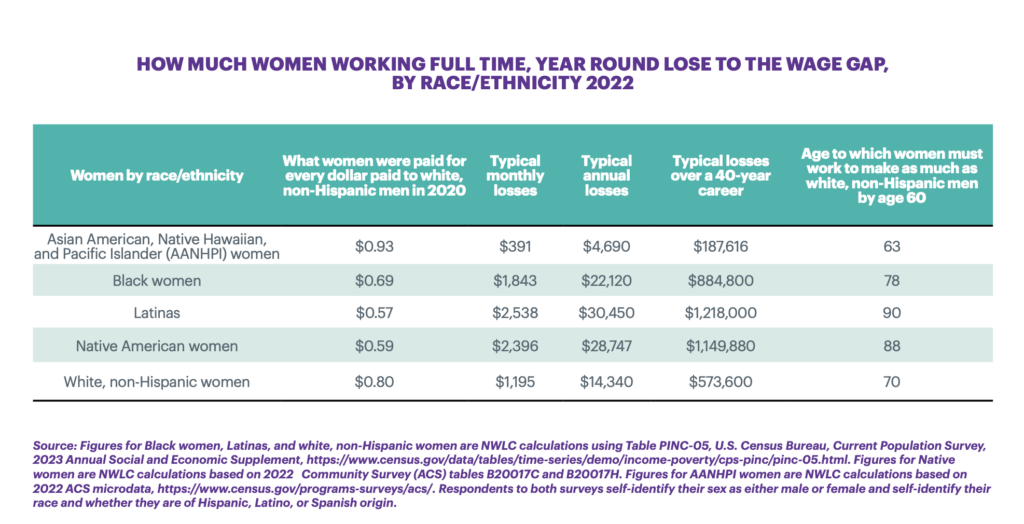
March 12, right in the middle of Women’s History Month and four days after International Women’s Day, was Equal Pay Day. Women must work until March 12 to catch up to what white men were paid by December 31, 2023.
Women are still paid 78% of white men’s pay, with little change seen since the 1990s, but even that wasn’t progress because it was men’s falling wages that accounted for it as Reaganomics tightened its stranglehold on the American working class.
But March 12 is only for white women; it’s much worse for women of color.
- Black women are paid only 70% of white men receive.
- Hispanic women — 65%
- Native women — 55%
If one looks at the hourly wage versus the average wage, it’s even worse because the highly paid workers who skew the average are white men. The gap persists no matter how it’s measured.
The lowest wage workers have the smallest gap as they are all abused by the lack of a living wage. Women still get $1.86 less per hour than men. In the middle-wage range, it’s $3.87 less per hour. So, women lose $3,800 to $8,000 per year, which adds up to a house down payment, college tuition or a lot of diapers. The lower pay also degrades the ultimate pension or social security the woman will receive in retirement. At the highest wage level, women earn $14.74 less an hour. So that woman is losing $30,000 a year.
Women with advanced degrees get less than men with college degrees.
It doesn’t matter how much education you have; women are paid less at every educational level, from high school to postgraduate. Women with advanced degrees get less than men with college degrees. (Data from Economic Policy Institute, Gender wage gap persists in 2023, Elise Gould, posted March 8, 2024.)
Women are punished for many reasons, including occupational segregation into blue and pink ghettos, devaluing women’s work, especially caregiving, and both overt and subtle discrimination. The result of this punishment for being born a woman is a lifetime loss of millions of dollars, as outlined in the National Women’s Law Center, March 2024, Fact Sheet by Sarah Javaid.
Women, in general, lose $400,000 over a 40-year career. For women of color, the loss ranges from $200,000 to over $1 million. For professional women, it can be over $2 million. This has a dramatic impact on her pension, social security, and retirement income. To equal men’s pay by age 60, white women must work to 68, and Black, Hispanic, and Native women would have to work beyond their life span to age 80-90.

While the wage gap continues, women, especially mothers and pregnant women, continue to be harmed by the lack of health care, childcare, and workplace benefits. The number of women who left the labor force during COVID-19 due to lack of childcare pointed out yet another crisis.
In addition to childcare, medical costs for birth remain extremely high. The result consigns women to poverty. A landmark study of 10 years duration followed women who sought abortion. Those unable to access abortion fell deeper into poverty. These anti-woman policies most affect women of color and poor women. It is a race and class issue. (Economy, Chabeli Carranza, May 4, updated May 5, 2022)
Before the Dobbs decision, the court was well aware of the link between abortion and women’s participation in society. Mississippi argued that abortion had no impact on women in society which is a laughable proposition if it were not so harmful. Amici curiae were 154 distinguished economists and researchers with extensive experience in the field of causal inference. They occupy prominent positions at preeminent universities and institutions and include officers and distinguished fellows of the American Economic Association, affiliates of the National Bureau of Economic Research, and members of the National Academies of Sciences.
No paid leave, limited medical care for mothers
In the amicus brief, the economists laid out that we now have powerful and credible tools to measure the causal effects of policy changes. Research has shown that Roe did indeed change women’s lives in a positive direction. While employment policies (no paid leave, limited medical care) remain problematic to mothers, access to abortion had a positive effect on educational level and entering professional occupations. The Supreme Cult justices completely ignored this evidence. The more the evidence showed that abortion access led to social and economic advancement for women, the more the court scuttled backward to the 15th century to reverse that advancement.
Studies show that when abortion is legalized, women’s education, labor force participation, occupational prestige, and earnings all increase, especially for Black women. (Angrist and Evans, 1996; Kalist, 2004; Lindo, Pineda-Torres, Pritchard, and Tajali, 2020; Jones, 2021). Just one year delay in starting a family resulted in an 11% increase in hourly wages. Abortion access increased the likelihood of college graduation by 20% and of entering a professional occupation by 40%.
But after having a child, working mothers face a “motherhood wage penalty” that entails lower wages (Waldfogel, 1998; Anderson, Binder, and Krause, 2002; Kelven et al., 2019). Women’s earnings drop significantly, by one-third, when they become mothers. Many women cannot return to work since the U.S. is an outlier in not offering paid leave or affordable childcare. (Brookings: What can economic research tell us about the effect of abortion access on women’s lives? Caitlin Knowles Myers and Morgan Welch, Nov. 30, 2021.) At a presentation at the Arizona State Capital on 3/18/24, the deputy director of DES said that just in Arizona alone, $1.7 billion is lost annually because of childcare breakdowns.
The states most hostile to labor are the ones enacting abortion bans.
Our current economic policy is based on:
- Weak labor standards
- Lack of investment in public infrastructure and services
- High levels of incarceration
- Low levels of taxation for the rich and corporations
- Picking the pockets of the poor.

Abortion bans affect the willingness of workers to move to or from a state, to enter or exit a certain profession, and to bargain for appropriate health care. Banerjee’s article points out in easy-to-understand charts that states with abortion protections have a minimum wage $3.75/hour higher than banned/restricted states. States with abortion protections have a higher union density as well. In states with abortion protections, workers receive unemployment benefits at a rate 12 percentage points higher.
Women already face a steep pay gap, and denial of abortion only makes it worse. The conclusion of the extensive article is that the states with abortion restrictions are the same ones with lower wages, smaller unionization levels, worse unemployment benefits, less access to Medicaid, and more incarceration. Abortion bans, low wages, and public underinvestment are interconnected economic policy tools to disempower and control workers. (The economics of abortion bans, Asha Banerjee, Economic Policy Institute, January 18, 2023.)
The Institute for Women’s Policy Research also found that abortion access increased high school and college graduation, increased participation in the labor market, and reduced poverty. These findings were more prevalent among Black than white women. (The Economic Effects of Abortion Access: A Review of the Evidence Institute for Women’s Policy Research IWPR #B377 July 2019) Bloom et al. found that lower fertility increases women’s labor supply and contributes positively to GDP growth, including more investment in children’s human capital. (Rodgers YvdM, Coast E, Lattof SR, Poss C, Moore B (2021) The macroeconomics of abortion: A scoping review and analysis of the costs and outcomes. PLoS ONE 16(5): e0250692. https://doi.org/10.1371/journal.pone.0250692)
Abortion is one tool to use against workers to drive down education rates and drive up desperation to exploit workers, both women and men (who quit school to go to work and support the children). Organized labor must join women to stand up and fight back to build a strong worker-based economy that is fair to all.
* * *
Discover more from Blog for Arizona
Subscribe to get the latest posts sent to your email.
